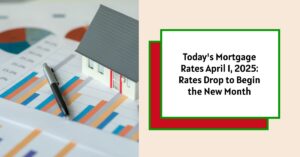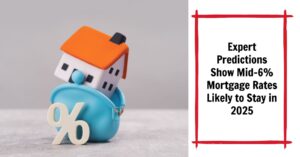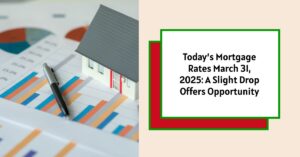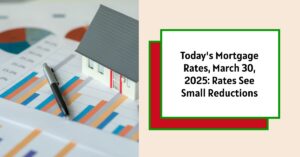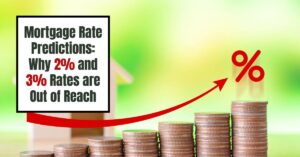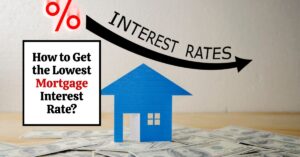If you're in the market to buy a house or thinking about refinancing, there's some welcome news to kick off April. Today's mortgage rates, on April 1, 2025, are showing a decrease, offering a bit of relief for those watching the market closely. According to the latest data, we're seeing a slight but positive shift downwards.
Today's Mortgage Rates April 1, 2025: Rates Drop to Begin the New Month
Key Takeaways:
- Mortgage rates are down today, April 1, 2025.
- The 30-year fixed mortgage rate has decreased to an average of 6.55%.
- 15-year fixed rates have also dropped, now averaging 5.83%.
- Refinance rates are also seeing a dip, although they generally remain a bit higher than purchase rates.
- Economic uncertainty continues to play a role in rate fluctuations.
- Experts suggest now might be a good time to consider buying as we head into the spring home-buying season.
Breaking Down Today's Mortgage Rate Drop
It's always encouraging to see mortgage rates take a step back, especially after the fluctuations we've experienced recently. Looking at the numbers from Zillow, we can see that across the board, rates are generally moving in a favorable direction today. This data, released today, April 1st, 2025, shows a clear easing in borrowing costs for homebuyers and those looking to refinance.
Let's dive into the specifics. For the benchmark 30-year fixed-rate mortgage, we're looking at an average of 6.55%. This is a decrease of four basis points. Now, four basis points might sound small, but in the world of mortgages, every little bit counts. For someone borrowing a significant amount of money, even a slight decrease can translate into real savings over the life of the loan.
The 15-year fixed-rate mortgage has seen an even more significant drop, falling by eight basis points to an average of 5.83%. This is a notable move and makes the shorter-term, but faster equity-building, 15-year mortgage even more attractive for those who can manage the higher monthly payments.
Here’s a quick look at the current average mortgage rates as of today, April 1, 2025, based on Zillow's data:
| Loan Type | Rate |
|---|---|
| 30-Year Fixed | 6.55% |
| 20-Year Fixed | 6.28% |
| 15-Year Fixed | 5.83% |
| 5/1 ARM | 6.77% |
| 7/1 ARM | 6.91% |
| 30-Year VA | 6.08% |
| 15-Year VA | 5.66% |
| 5/1 VA | 6.08% |
| 30-Year FHA | 5.95% |
| 5/1 FHA | 5.69% |
It's important to remember that these are national averages. The actual rate you'll qualify for can depend on a lot of personal factors, such as your credit score, down payment amount, and the specific lender you choose. Think of these numbers as a good starting point and a general indication of where the market is currently sitting.
Refinance Rates Also See a Decrease
The good news extends to those who are considering refinancing their existing mortgages. Refinance rates are also showing a downward trend today. While historically refinance rates tend to be a touch higher than purchase rates, the dip is still a positive sign for homeowners looking to potentially lower their monthly payments or tap into their home equity.
Here's a table outlining today's average mortgage refinance rates:
| Loan Type | Rate |
|---|---|
| 30-Year Fixed Refinance | 6.61% |
| 20-Year Fixed Refinance | 6.21% |
| 15-Year Fixed Refinance | 5.88% |
| 5/1 ARM Refinance | 6.93% |
| 7/1 ARM Refinance | 7.23% |
| 30-Year VA Refinance | 6.23% |
| 15-Year VA Refinance | 5.92% |
| 5/1 VA Refinance | 6.10% |
| 30-Year FHA Refinance | 6.10% |
| 15-Year FHA Refinance | 6.05% |
| 5/1 FHA Refinance | 6.63% |
Again, these are average refinance rates. Your personal rate will be determined by your individual financial profile and the specifics of your current mortgage. However, the general direction of rates is something to pay attention to if refinancing has been on your mind.
Fixed-Rate vs. Adjustable-Rate Mortgages: Making the Right Choice
When you're looking at mortgages, you'll generally come across two main types: fixed-rate and adjustable-rate mortgages (ARMs). Understanding the difference is crucial to making an informed decision about what's best for your situation.
A fixed-rate mortgage is pretty straightforward. The interest rate you get at the beginning of your loan stays the same for the entire term, whether it's 15, 20, or 30 years. This predictability is a big advantage. You know exactly what your monthly payment will be, making budgeting much easier. If you value stability and plan to stay in your home for a long time, a fixed-rate mortgage is often a solid choice. The 30-year fixed is probably the most popular choice because it generally offers the lowest monthly payments, though you'll pay more interest over the long haul compared to shorter terms.
On the other hand, an adjustable-rate mortgage (ARM) has an interest rate that changes periodically after an initial fixed period. For example, a 5/1 ARM has a fixed rate for the first five years, and then the rate adjusts once a year for the remaining term. Similarly, a 7/1 ARM has a fixed rate for seven years, and then adjusts annually.
ARMs can sometimes start with lower interest rates than fixed-rate mortgages, which might seem appealing at first. However, the risk is that your rate could increase in the future, leading to higher monthly payments. The data mentions that recently, ARM rates have even been starting higher than fixed rates, which makes them less attractive right now. Typically, ARMs are considered by those who expect to move or refinance before the rate adjusts, or those who believe interest rates will fall in the future. However, with economic uncertainty still in the air, the predictability of a fixed-rate mortgage is often seen as a safer bet for most homebuyers.
30-Year vs. 15-Year Fixed Mortgages: A Tale of Two Terms
Another important decision is choosing between a 30-year and a 15-year fixed mortgage. Both offer the security of a fixed interest rate, but they differ significantly in terms of monthly payments and total interest paid over the life of the loan.
The 30-year mortgage is the more common choice because it spreads your payments out over a longer period, resulting in lower monthly payments. This can make homeownership more accessible from a monthly budget perspective. However, the trade-off is that you'll pay significantly more interest over 30 years.
The 15-year mortgage, on the other hand, requires higher monthly payments because you're paying off the loan in half the time. But the big advantage is that you build equity much faster and pay considerably less interest overall. Plus, as we see in today's rates, 15-year mortgages typically come with lower interest rates compared to 30-year mortgages.
Let's look at an example to illustrate this. Imagine you're borrowing $400,000.
- With a 30-year mortgage at 6.55%, your estimated monthly payment (principal and interest) would be around $2,541. Over 30 years, you would pay approximately $514,918 in interest.
- With a 15-year mortgage at 5.83%, your estimated monthly payment would be about $3,339. However, over 15 years, you would pay only around $200,984 in interest.
That’s a massive difference of over $300,000 in interest saved by choosing the 15-year mortgage! While the monthly payment is higher, the long-term savings are substantial. Of course, it's all about what fits your budget and financial goals. Even if a 15-year mortgage payment feels too high right now, it's worth remembering that you can always make extra payments on a 30-year mortgage to pay it off faster and save on interest, while still having the flexibility of a lower minimum monthly payment if needed.
Recommended Read:
Mortgage Rates Trends as of March 31, 2025
Will Mortgage Rates Go Down in April 2025? Here's What the Experts Say
Mortgage Rates Drop: Can You Finally Afford a $400,000 Home?
Expect High Mortgage Rates Until 2026: Fannie Mae's 2-Year Forecast
What's Driving Mortgage Rates Right Now?
Understanding what influences mortgage rates can help you anticipate future movements and make informed decisions. The data we have today mentions a few key factors that are currently at play.
Economic Uncertainty: The overall economic climate has a big impact on mortgage rates. When there's a lot of uncertainty about the economy's future, it can cause rates to fluctuate. This uncertainty can stem from various sources, like inflation concerns, global events, or changes in government policy. As the data suggests, as long as economic uncertainty persists, we might not see dramatic swings in mortgage rates in either direction.
Tariffs and Inflation: Tariffs, which are taxes on imported goods, can have a ripple effect on the economy. They can potentially lead to higher inflation because businesses might pass on the cost of tariffs to consumers in the form of higher prices. Tariffs can also curb economic growth by making goods more expensive and potentially reducing trade. The data points out that upcoming tariffs and any flexibility in their implementation are factors to watch as they could push mortgage rates up or down.
Labor Market Data: The health of the job market is another crucial indicator. Data on employment, unemployment, and wages gives insights into the strength of the economy. Strong labor market data can sometimes lead to concerns about inflation, which can then influence mortgage rates. The data mentions that updated labor market figures this week could also impact rate movements.
Federal Reserve (The Fed): The Federal Reserve, the central bank of the United States, plays a significant role in influencing interest rates across the economy. They control the federal funds rate, which is the rate banks charge each other for overnight lending. While the federal funds rate isn't directly mortgage rates, it influences them. The data highlights that the Fed's decisions on whether to cut the federal funds rate at their meetings will be a major factor in the future direction of mortgage rates. The fact that the Fed didn't cut rates in their January or March meetings, and is expected to hold steady in May, suggests we might not see significant rate drops in the immediate future.
Looking Ahead: Mortgage Rate Forecast for April and Beyond
So, what can we expect in April and the rest of 2025? While it's impossible to predict the future with certainty, the data and expert opinions give us some clues.
The general expectation is that mortgage rates are likely to decrease slightly in 2025, but they probably won't plummet back to the historic lows we saw a few years ago. The extent of any rate decrease will depend on how the economy performs. If the economy remains stable, rate drops might be modest. If inflation proves to be persistent or even increases again, rates could actually rise.
Experts don't anticipate rates returning to the sub-3% levels of 2020 and 2021 anytime soon. However, there's a possibility that rates could settle somewhere in the 6% range over the next couple of years. This is still higher than the rock-bottom rates of the recent past, but it's also lower than some of the peaks we've seen more recently.
Interestingly, while mortgage rates might see some moderation, home prices are not expected to decline. In fact, most forecasts suggest home prices will continue to rise, albeit at a more moderate pace than in recent years. The main reason for this is the historically low supply of homes for sale. Limited inventory puts upward pressure on prices, even if demand cools down somewhat. Fannie Mae researchers are predicting a 3.5% increase in home prices in 2025, while the Mortgage Bankers Association expects a 1.3% rise.
When will we see a significant drop in mortgage rates? Economists don't foresee drastic rate cuts happening before the end of 2025. In 2024, rates trended down for a period after the Fed signaled a rate cut, but since then, rates have mostly held steady or increased slightly. The future trajectory hinges heavily on the Fed's decisions regarding the federal funds rate.
In conclusion, today's dip in mortgage rates is a welcome sign, especially for those navigating the spring home-buying season. While significant drops might not be on the immediate horizon, the expectation of gradual moderation in rates over time, coupled with continued home price appreciation, underscores the importance of being informed and prepared when entering the housing market. Getting quotes from multiple lenders is always a smart move to ensure you secure the best possible rate in this dynamic environment.
Work With Norada, Your Trusted Source for
Real Estate Investment in the U.S.
Investing in turnkey real estate can help you secure consistent returns with fluctuating mortgage rates.
Expand your portfolio confidently, even in a shifting interest rate environment.
Speak with our expert investment counselors (No Obligation):
(800) 611-3060
Also Read:
- Will Mortgage Rates Go Down in 2025: Morgan Stanley's Forecast
- Mortgage Rate Predictions 2025 from 4 Leading Housing Experts
- Mortgage Rates Forecast for the Next 3 Years: 2025 to 2027
- 30-Year Mortgage Rate Forecast for the Next 5 Years
- 15-Year Mortgage Rate Forecast for the Next 5 Years
- Why Are Mortgage Rates Going Up in 2025: Will Rates Drop?
- Why Are Mortgage Rates So High and Predictions for 2025
- Will Mortgage Rates Ever Be 3% Again in the Future?
- Mortgage Rates Predictions for Next 2 Years
- Mortgage Rate Predictions for Next 5 Years
- Mortgage Rate Predictions: Why 2% and 3% Rates are Out of Reach
- How Lower Mortgage Rates Can Save You Thousands?
- How to Get a Low Mortgage Interest Rate?
- Will Mortgage Rates Ever Be 4% Again?
